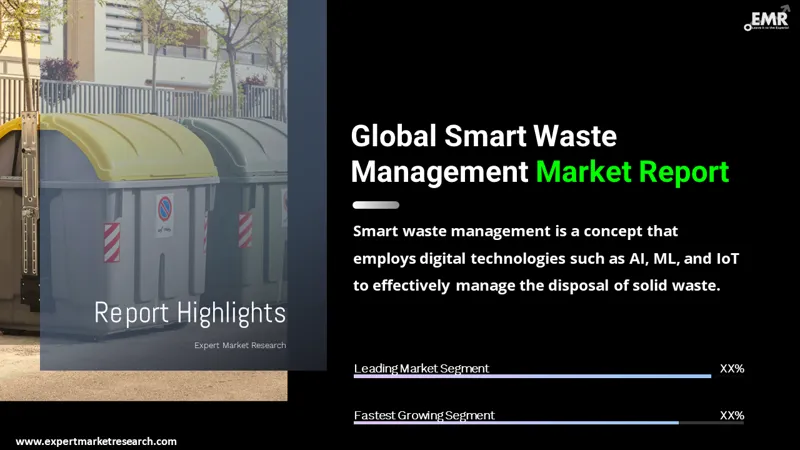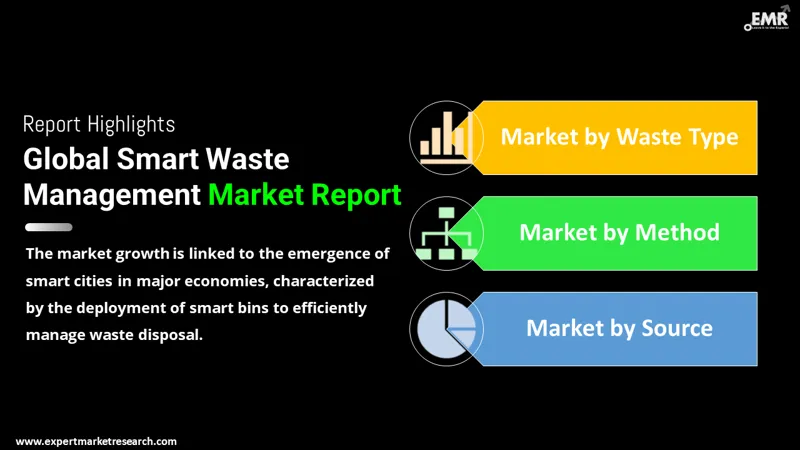
Consumer Insights
Uncover trends and behaviors shaping consumer choices today
Procurement Insights
Optimize your sourcing strategy with key market data
Industry Stats
Stay ahead with the latest trends and market analysis.
The global smart waste management market size attained a value of approximately USD 3.11 Billion in 2025. The market is further expected to grow in the forecast period of 2026-2035 at a CAGR of 10.80%, reaching a value of around USD 8.67 Billion by 2035.
Base Year
Historical Period
Forecast Period
Compound Annual Growth Rate
10.8%
Value in USD Billion
2026-2035
*this image is indicative*
Reducing costs of smart waste management systems and rising economic benefits they offer are positively influencing the smart waste management market. Various industries, residential complexes, and commercial establishments are investing in a variety of smart waste management techniques due to a growing concern for the environment and strict environmental laws by various governments.
Rapid industrialisation and increasing population are leading to a heightened generation of waste, and with growing focus on sustainability there is greater importance on adequate waste management. Smart waste management aids in monitoring the collection of waste, its transportation, and disposal, streamlining the entire process and reducing pile-ups on landfills. Increasing focus on recycling and reducing manual labour needs in waste management are anticipated to increase the demand for smart waste management in the forecast period.

Read more about this report - REQUEST FREE SAMPLE COPY IN PDF
The global market for smart waste management is being driven by the advent of advanced digital technologies like Artificial Intelligence (AI), Machine Learning (ML), and the Internet of Things (IoT). Artificial Intelligence is substantially contributing to the development of smart waste management systems providing profitable smart waste management market opportunities. Smart bins that are equipped with Internet of Things (IoT) technology aid in optimising garbage collection, while machine learning (ML) is further used to identify, categorise, and sort waste immediately after it is thrown away.
AI, ML, robotics, IoT, and other innovative technologies have allowed municipal authorities to minimise manual labour, cut costs, and maximise efficiency. Moreover, with rising concerns regarding sustainability, the process of waste management and recycling is becoming an utmost priority, thereby promoting the adoption of smart waste management and increasing the global smart waste management market demand.

Read more about this report - REQUEST FREE SAMPLE COPY IN PDF
Smart waste management refers to the usage of technology to improve waste management for more efficient, environmentally friendly, and cost-effective results. Depending upon the type of waste generated and the stage of waste management, the applicable systems and processes can vary.
Breakup by Waste Type
Breakup by Method
Breakup by Source
Breakup by Region
The development of smart cities is catalysing the growth of the global market for smart waste management. Smart cities are software-driven infrastructures in which day-to-day operations are computerised using technologies like AI and IoT. With rapid urbanisation and industrialisation, investments in infrastructural projects are contributing to the development of smart cities, bolstering the market for smart waste management. Smart bins, powered through IoT technology, are deployed to effectively differentiate between different kinds of wastes with the help of sensors.
Furthermore, improvements in technology and product design to incorporate features such as weight management and improved logistics, are expected to bolster the growth of smart waste management system market in the coming years. Moreover, robust investments into progressive technologies, smart infrastructures, and waste management systems are boosting the market growth.
The report presents a detailed analysis of the following key players in the global smart waste management market, looking into their capacity, market share, and latest developments like capacity expansions, plant turnabouts and mergers and acquisitions:
The comprehensive report looks at the micro and macro aspects of the market. The EMR report gives an in-depth insight into the market by providing a SWOT analysis as well as an analysis of the Porter’s Five Forces Model.
Trade Surveillance System Market
United Kingdom Carbon Dioxide Market
South Africa Conveyor Belt Market
North America Battery Storage Service Market




*While we strive to always give you current and accurate information, the numbers depicted on the website are indicative and may differ from the actual numbers in the main report. At Expert Market Research, we aim to bring you the latest insights and trends in the market. Using our analyses and forecasts, stakeholders can understand the market dynamics, navigate challenges, and capitalize on opportunities to make data-driven strategic decisions.*
Get in touch with us for a customized solution tailored to your unique requirements and save upto 35%!
The global market for smart waste management attained a value of approximately USD 3.11 Billion in 2025.
The market is projected to grow at a CAGR of 10.80% between 2026 and 2035.
The market is estimated to witness a healthy growth in the forecast period of 2026-2035, reaching a value of around USD 8.67 Billion by 2035.
The major market drivers include increasing generation of waste worldwide, rising importance of adequate waste management, and incorporation of advanced digital technologies like AI, IoT, and ML into waste management.
The key smart waste management market trends include rising development of smart cities in major economies, increasing regulations pertaining to waste handling, and cost-savings offered by smart waste management.
The major regional markets for smart waste management are North America, Latin America, the Asia Pacific, Europe, and the Middle East and Africa.
The significant waste types in the market for smart waste management are solid waste, special waste, and e-waste.
The different methods of smart waste management are smart collection, smart processing, and smart disposal.
The leading sources of smart waste management in the market are residential, commercial, and industrial.
The major players in the market are Covanta Holding Corporation, Veolia Environnement S.A., Republic Services, Inc., Sensoneo j.s.a., BigBelly, Inc., SUEZ Smart Solutions, Evreka, Ecube Labs Co Ltd, and Enevo, Inc., among others.
Explore our key highlights of the report and gain a concise overview of key findings, trends, and actionable insights that will empower your strategic decisions.
| REPORT FEATURES | DETAILS |
| Base Year | 2025 |
| Historical Period | 2019-2025 |
| Forecast Period | 2026-2035 |
| Scope of the Report |
Historical and Forecast Trends, Industry Drivers and Constraints, Historical and Forecast Market Analysis by Segment:
|
| Breakup by Waste Type |
|
| Breakup by Method |
|
| Breakup by Source |
|
| Breakup by Region |
|
| Market Dynamics |
|
| Competitive Landscape |
|
| Companies Covered |
|
Datasheet
One User
USD 2,499
USD 2,249
tax inclusive*
Single User License
One User
USD 3,999
USD 3,599
tax inclusive*
Five User License
Five User
USD 4,999
USD 4,249
tax inclusive*
Corporate License
Unlimited Users
USD 5,999
USD 5,099
tax inclusive*
*Please note that the prices mentioned below are starting prices for each bundle type. Kindly contact our team for further details.*
Flash Bundle
Small Business Bundle
Growth Bundle
Enterprise Bundle
*Please note that the prices mentioned below are starting prices for each bundle type. Kindly contact our team for further details.*
Flash Bundle
Number of Reports: 3
20%
tax inclusive*
Small Business Bundle
Number of Reports: 5
25%
tax inclusive*
Growth Bundle
Number of Reports: 8
30%
tax inclusive*
Enterprise Bundle
Number of Reports: 10
35%
tax inclusive*
How To Order

Select License Type
Choose the right license for your needs and access rights.

Click on ‘Buy Now’
Add the report to your cart with one click and proceed to register.

Select Mode of Payment
Choose a payment option for a secure checkout. You will be redirected accordingly.
Gain insights to stay ahead and seize opportunities.

Get insights & trends for a competitive edge.

Track prices with detailed trend reports.

Analyse trade data for supply chain insights.

Leverage cost reports for smart savings

Enhance supply chain with partnerships.

Connect For More Information
Our expert team of analysts will offer full support and resolve any queries regarding the report, before and after the purchase.
Our expert team of analysts will offer full support and resolve any queries regarding the report, before and after the purchase.
We employ meticulous research methods, blending advanced analytics and expert insights to deliver accurate, actionable industry intelligence, staying ahead of competitors.
Our skilled analysts offer unparalleled competitive advantage with detailed insights on current and emerging markets, ensuring your strategic edge.
We offer an in-depth yet simplified presentation of industry insights and analysis to meet your specific requirements effectively.
Share